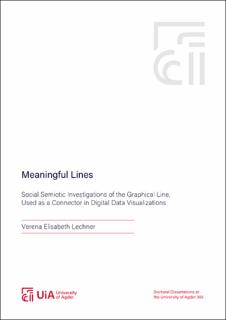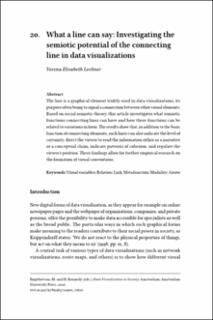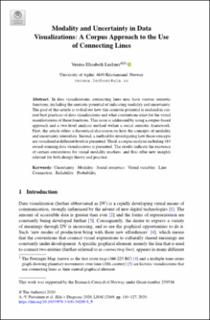| dc.contributor.author | Lechner, Verena Elisabeth | |
| dc.date.accessioned | 2020-12-01T09:30:25Z | |
| dc.date.available | 2020-12-01T09:30:25Z | |
| dc.date.created | 2020-11-26T11:06:34Z | |
| dc.date.issued | 2020 | |
| dc.identifier.citation | Lechner, V. E. (2020). Meaningful lines : Social semiotic investigations of the graphical line, used as a connector in digital data visualizations (Doctoral thesis). University of Agder, Kristiansand. | en_US |
| dc.identifier.isbn | 978-82-8427-004-3 | |
| dc.identifier.issn | 1504-9272 | |
| dc.identifier.uri | https://hdl.handle.net/11250/2711099 | |
| dc.description | The paper III is not published yet. | en_US |
| dc.description.abstract | The dissertation investigates the graphical line, used as a connector in digital data visualizations (DVs), from a social semiotic perspective. It explores the semiotic functions of connecting lines in digital DVs, building empirically on two corpus analyses. These analyses are concerned with how two key semiotic functions are graphically realized in the selected lines and whether graphical conventions regulating these realizations can be identified.
In the dissertation the connecting line is researched as a central element of several different DV types – line graphs, timelines, route maps, connection maps, network diagrams, etc. Today, DVs are used in a broad range of social contexts and thus play an essential role in society. New digital technologies make it possible to apply other visual characteristics to graphical lines in DVs than was previously possible, for example, when they were hand-drawn or printed. This change may have influenced the DV design practice, a situation calling for updated research.
The dissertation is article-based, comprising three articles and an extended abstract. The extended abstract frames the three articles and includes an introduction, definitions of key terms, more comprehensive sections on the theoretical framework, earlier research and methodology, as well as ethical considerations, reflections on methodological decisions and a conclusion. The two overall research questions addressed in the dissertation are:
(1) What characterizes the graphical forms and semiotic functions of connecting lines in current, publicly available digital DVs?
(2) What conventions, regulating the relations between these forms and functions, can be observed in such DVs? | en_US |
| dc.language.iso | eng | en_US |
| dc.publisher | 07 Media | en_US |
| dc.relation.ispartofseries | Doctoral Dissertations at the University of Agder; no. 302 | |
| dc.relation.haspart | Paper I: Lechner, V. E. (2020). What a line can say: Investigating the semiotic potential of the connecting line in data visualizations. In M. Engebretsen & H. Kennedy (Ed.), Data Visualization in Society (p. 329-346). Amsterdam University Press. https://doi.org/10.5117/9789463722902_ch20. Published version. Full-text is available in AURA as a separate file: https://hdl.handle.net/11250/2711113. | en_US |
| dc.relation.haspart | Paper II: Lechner, V. E. (2020). Modality and uncertainty in data visualizations: A corpus approach to the use of connecting lines. Lecture Notes in Computer Science, 12169, 110-127. https://doi.org/10.1007/978-3-030-54249-8_9. Published version. Full-text is available in AURA as a separate file: https://hdl.handle.net/11250/2686092. | en_US |
| dc.relation.haspart | Paper III: Lechner, V. E. (Forthcoming). Arrows and Their Modern Versions: Narrativity Signalled by Lines in Data Visualizations. Journal of Visual Literacy. Author´s submitted manuscript. Full-text is not available in AURA as a separate file. | en_US |
| dc.title | Meaningful lines : Social semiotic investigations of the graphical line, used as a connector in digital data visualizations | en_US |
| dc.type | Doctoral thesis | en_US |
| dc.description.version | publishedVersion | en_US |
| dc.rights.holder | © 2020 Verena Elisabeth Lechner | en_US |
| dc.subject.nsi | VDP::Samfunnsvitenskap: 200::Medievitenskap og journalistikk: 310 | en_US |
| dc.source.pagenumber | 287 | en_US |
| dc.source.issue | 302 | en_US |
| dc.identifier.cristin | 1852729 | |
| dc.relation.project | Norges forskningsråd: 259536 | en_US |


